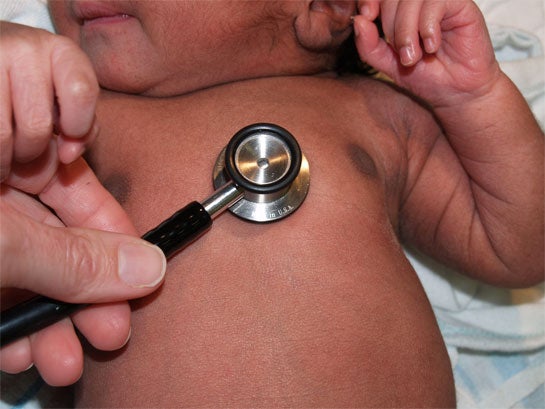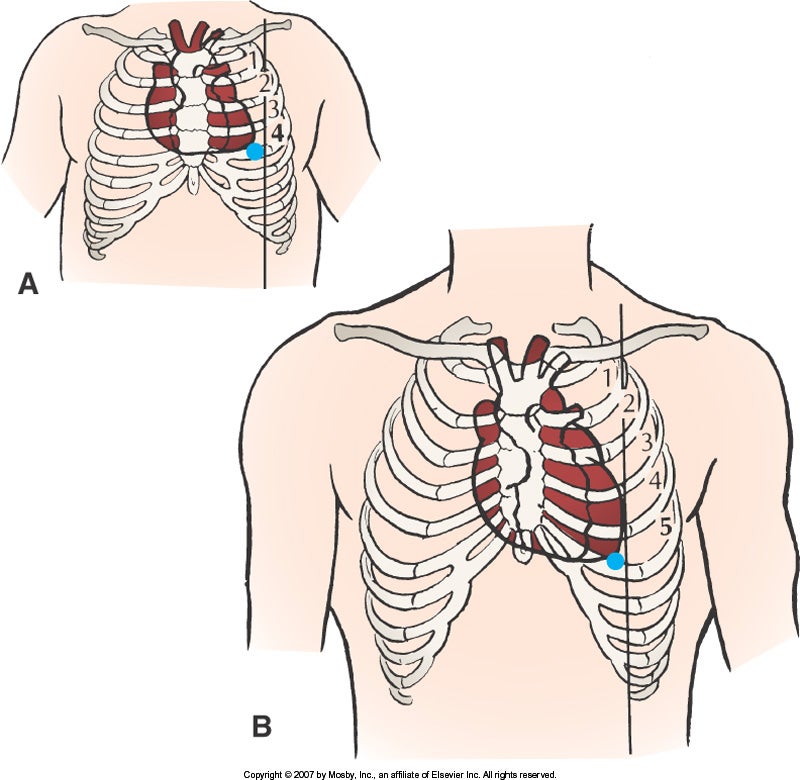VITAL SIGNS
Vital signs for the infant include heart rate, respirations and temperature. Initially the vital signs are monitored every half hour for the first two hours after birth. After stabilization, newborn assessments including vital signs occur every four to eight hours.
It is easiest to assess the heart rate and respirations while the infant is quiet. If the infant is crying, you may try to calm the infant by wrapping and rocking the infant. You may also insert a clean, gloved finger into the infant's mouth. The infant's suck will be initiated and the infant will quiet.
Heart Rate
Auscultate the apical heart rate at the border of the left sternum for a full minute.
Note: The PMI of the infant's heart is lateral to the midclavicular line at the left lower sternal border at the 4th ICS whereas the adult's PMI is at the 5th ICS (see pictue on the right).
of the infant's heart is lateral to the midclavicular line at the left lower sternal border at the 4th ICS whereas the adult's PMI is at the 5th ICS (see pictue on the right).
Picture used with permission Dr. Janelle Aby, Stanford Medical School, Palo Alto, CA Elsevier
The infant's normal heart rate is 120-160 beats per minute and irregular
and irregular . During sleep the heart rate may decrease to 100. After birth or while crying, the heart rate may be as high as 180. If you have difficulty counting the heart rate, tap your finger or foot with each beat. Be patient. Counting a newborn's heart rate for a minute takes PRACTICE. After you have counted for a minute, move to each of the four areas of the heart to listen for a heart murmur or heart irregularities.
. During sleep the heart rate may decrease to 100. After birth or while crying, the heart rate may be as high as 180. If you have difficulty counting the heart rate, tap your finger or foot with each beat. Be patient. Counting a newborn's heart rate for a minute takes PRACTICE. After you have counted for a minute, move to each of the four areas of the heart to listen for a heart murmur or heart irregularities.
Respirations
During inspirations observe the bilateral expansion of the barrel-shaped chest. Observe for symmetry and retractions.
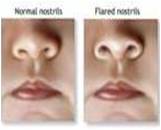
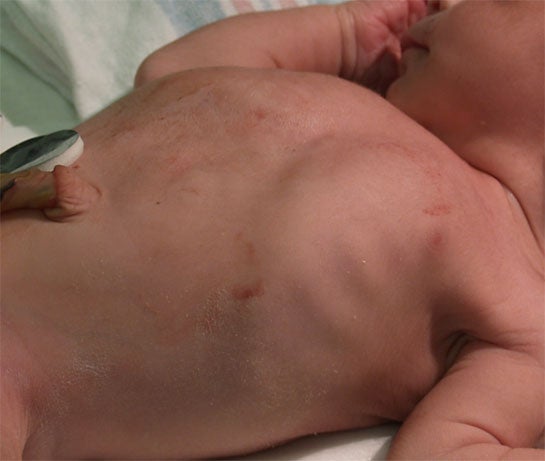
Left: Normal nares vs. nasal flaring Right:Intracostal retractions
Observe for signs of respiratory distress which include: nasal flaring, intercostal retractions between the ribs, or a grunting or a singing noise with inspiration.
Count the respiratory rate for a full minute. You may want to observe the rise and fall of the abdomen as you count the respirations. The respiratory rate is irregular due to the immature neurological system. The best position to listen is the opposite side from the heart. The normal rate is 30 to 60 breaths per minute . A respiratory rate that is tachypneic
. A respiratory rate that is tachypneic or bradypneic
or bradypneic two hours after delivery may indicate a problem. Listen to bilateral breath sounds from the base (bottom) of the lungs to the apex (top) of the lungs with the infant lying on his/her back. Note the presence of crackles or wheezes.
two hours after delivery may indicate a problem. Listen to bilateral breath sounds from the base (bottom) of the lungs to the apex (top) of the lungs with the infant lying on his/her back. Note the presence of crackles or wheezes.
Although not a part of the vital signs, assess the abdomen. Observe the soft, dome-shaped, round abdomen which moves with respirations. Listen to the four quadrants for bowel sounds. You may now put aside your stethoscope. Usually the abdomen is not palpated.
Temperature
The axillary temperature is taken by inserting the digital thermometer under the axilla in line with the infant's arm. Hold the infant's arm firmly against the thermometer. The infant may cry. Be patient. It will be over soon.
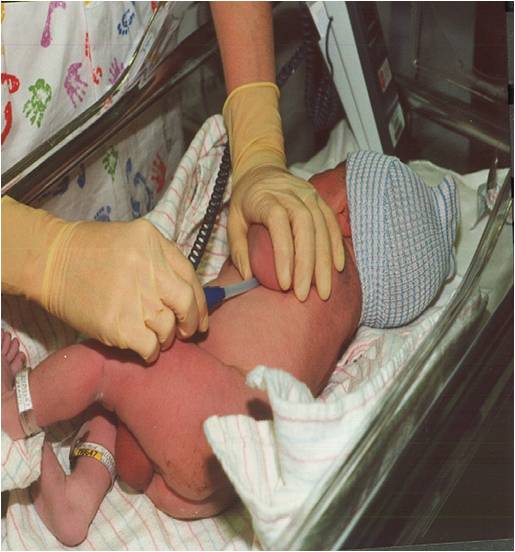
The normal axillary temperature is 36.5 to 37.2 C. Due to wetness after birth and lack of body fat, infants are at risk for hypothermia. The infant should be uncovered for a very short period of time. The infant hat maintains body warmth. The first bath is not given until the infant has three temperatures above 36.5 C
Due to wetness after birth and lack of body fat, infants are at risk for hypothermia. The infant should be uncovered for a very short period of time. The infant hat maintains body warmth. The first bath is not given until the infant has three temperatures above 36.5 C . The axillary temperature is the method of choice until age 6.
. The axillary temperature is the method of choice until age 6.
Note: The heart rate, respirations and temperature can be completed when the infant is held skin-to-skin by the mother. The stable infant does not need to return to the radiant warmer for assessments. It is always important to complete the assessments rapidly to prevent hypothermia .
.
Inability to maintain temperature (inadequate thermoregulation) can be the first sign of infection or sepsis for the infant. In addition to a temperature less than 36.5 C, other signs of infection may include rapid respirations and inadequate feeding. Note that infants may have a low temperature whereas adults have an elevated temperature with infection.
other signs of infection may include rapid respirations and inadequate feeding. Note that infants may have a low temperature whereas adults have an elevated temperature with infection.
A more complete head-to-toe examination follows the initial rapid assessment and vital signs. It may be delayed until the mother has breastfed her infant or held the infant skin-to-skin.
Test your memory...
